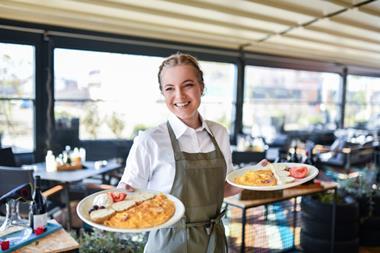Operators are constantly looking for innovative ways to grow their estate, footfall and offering. Benoit Broch, at Livingbridge, looks at trends that may shape hospitality businesses of the future.
The rise of vegans, vegetarians and flexitarians
Veganism has increased by 360% in Great Britain over the last decade making it the country’s fastest growing lifestyle movement1. More than a third of people now identify themselves as flexitarians, whilst additionally, 29% of consumers are now trying to reduce their meat consumption.
This movement represents a shift in consumer attitudes, with concerns now extending beyond animal welfare to include the health and environmental implications. In fact, almost a third of Brits under 25 would consider going meat-free to protect the environment.
Since Pret launched its two London-based vegetarian pop-up sites in 2016, sales of its vegetarian items experienced double digit growth. However, operators need to be aware that there is no need to go full-veggie to take advantage of the trend. Currently, those describing dishes as ‘light’ or ‘fresh’, as opposed to ‘vegetarian’ or ‘vegan’, are more likely to see a rise in meat-free sales. The insight here for operators is that consumers are eating for better health or a cleaner footprint – a lifestyle trend that is here to stay.
Generational gap in alcohol consumption
The generational gap in alcohol consumption is widening, with 27% of millennials now teetotal, representing an 8% rise over the past decade.
Google Trends indicates that searches for the term “benefits of quitting drinking” rose by around 70% in the last five years. It is these benefits that are driving consumers to reduce or limit their alcohol intake. In fact, more than two in five drinkers in the UK have decreased their alcohol consumption in order to save money, 41% to lose or avoid gaining weight and 39% to improve personal health.
This presents a significant opportunity for hospitality operators to increase their drinks offering to embrace low-alcohol and non-alcoholic choices. . And since we know the drivers for the trend, it is worth also looking at highlighting lower calorie content, or offering good cost-effective alternatives.
Brewer AB InBev, as part of its Global Smart Drinking Goals (GSDGs) launched in 2015, has recognised that there is an appetite amongst consumers to better understand and manage alcohol consumption. The business has pledged to add guidance labels to all its beer products by the end of 2025, ensuring that its brands come served with a side of advice. As part of this commitment, the brewer has also pledged to empower consumers to make smart drinking choices by ensuring they have access to non-alcohol or low-alcohol options.
The shift in consumer behaviours and appetite for non-alcoholic options, does not need to be seen by operators as a negative. Rather than shy away from the bar-sales dampener that Dry January often brings, Harvey Nichols took the opposite approach, ramping up its drinks promotions to offer customers unusual non-alcoholic cocktails, which no doubt had the added benefit of attracting new customers to its famous Fifth Floor bar. The learning here for operators is to ensure your customers know you sell non-alcoholic drinks which are a step away from the norm.
Boom in the experience economy
Spending in restaurants, pubs and entertainment venues during the last three months of 2016 was up 8% compared to the year before. This was largely due to progressive operators stepping beyond the realms of what is expected to capture the market’s imagination with new adventures and experiences for customers.
Take Everyman Cinemas, an independent network of boutique cinemas that the Baronsmead Venture Capital Trusts have been a shareholder in since 2013. They position the brand around creating memorable experiences which exceed expectations across food, drink, seating and films. The quote on their website says it all: “Cinema should make you forget you are sitting in a theatre.”
On the restaurant scene, rhubarb is setting a fine example of a brand delivering a unique customer experience. Located 36 floors up in the Sky Garden, the operator is offering customers the perfect setting for sunrise yoga classes and breakfast, set amongst greenery and a backdrop of incredible city views. It invites customers to take to the mat in a unique and peaceful urban location to provide not only a memorable experience but one that is also instantly Instagrammable. Not to be outdone in the social stakes, Netil360 and The Alchemist are two further examples of an operator designing each individual venue explicitly to ensure it makes it onto every customer’s social feed.
If you can leave customers intrigued as to what they can expect on their return visit, it is a sure-fire way to build a loyal customer base. Take Street Feast, which transforms derelict and disused spaces into unique eating and drinking environments; it offers customers something different every time. Brands that react quickly to changing trends can make the most of this spontaneous and shareable world to build a socially-active and loyal customer base.
Harnessing big data to better connect with customers
In a world where almost half of millennials expect personalisation in their interactions with businesses, data is king. Whilst digital technology has made consumers’ lives easier, it has also made them more demanding. Personalisation is now a consumer expectation.
According to Gourmet Burger Kitchen CEO Alasdair Murdoch, loyalty rewards, referral schemes and click and collect functions have allowed them to connect with 1.5 million customers via their smartphones. One million of these are active customers who on average account for 25% more repeat business than those without the app. This trend has sparked a rise in the relevance of companies such as Wireless Social, which make it easier for operators to acquire valuable information about their customers. By enabling customers to log on to an operator’s Wi-Fi using their Facebook profile, operators can obtain a direct email contact, together with their preference on type of device, interests and hobbies. Using this information, operators can tailor their offers and better target their campaigns to nurture repeat business.
Delivering the future
It is no secret that delivery services, such as Just Eat, Deliveroo and UberEATS, are taking the hospitality industry by storm, with the market valued at £3.6bn last year, a 6% increase on 2015 and 50% more than in 2008.
Despite this, many operators are still torn as to whether or not to take the plunge. They have concerns about handing over responsibility to independent delivery contractors, who are unlikely to be as invested in their brand as they are. Similarly, positioned as an additional revenue stream, some worry that the adoption of delivery may cannibalise the number of customers eating in. Margins are also lower due to the commission operators must pay to the service provider and consumer spending habits can be less favourable because, for example, they may not order a drink.
If operators do decide to take part in the anticipated £11.2bn market, the key to its successful delivery is overcoming the operational challenges. Is your kitchen set up to do both delivery and dine-in without competing for kitchen orders? And how well can it deal with a sudden influx of orders? The operators that will reap the benefits of this to-the-door consumerism are those who truly understand how it can help grow their business and most importantly, have set up operations accordingly to maximise it.
Benoit Broch is investment director at mid-market private equity firm, Livingbridge










































